Google's Tensor inside of Pixel 6, Pixel 6 Pro: A Look into Performance & Efficiency
by Andrei Frumusanu on November 2, 2021 8:00 AM EST- Posted in
- Mobile
- Smartphones
- SoCs
- Pixel 6
- Pixel 6 Pro
- Google Tensor
Google's IP: Tensor TPU/NPU
At the heart of the Google Tensor, we find the TPU which actually gives the chip is marketing name. Developed by Google with input and feedback by the team’s research teams, taking advantage of years of extensive experience in the field of machine learning, Google puts a lot of value into the experiences that the new TPU allows for Pixel 6 phones. There’s a lot to talk about here, but let’s first try to break down some numbers, to try to see where the performance of the Tensor ends up relative to the competition.
We start off with MLCommon’s MLPerf – the benchmark suite works closely with all industry vendors in designing something that is representative of actual workloads that run on devices. We also run variants of the benchmark which are able to take advantage of various vendors SDKs and acceleration frameworks. Google had sent us a variant of the MLPerf app to test the Pixel 6 phones with – it’s to be noted that the workloads on the Tensor run via NNAPI, while other phones are optimised to run through the respective chip vendor’s libraries, such as Qualcomm’s SNPE, Samsung’s EDEN, or MediaTek’s Neuron – unfortunately only the Apple variant is lacking CoreML acceleration, thus we should expect lower scores on the A15.

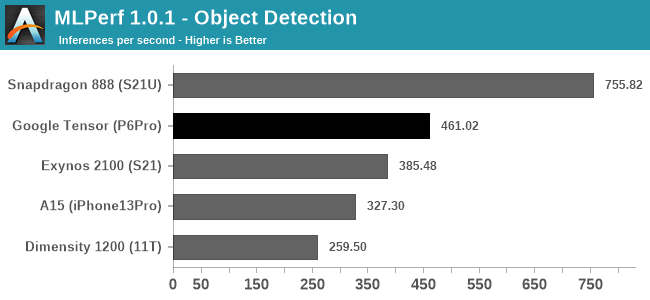
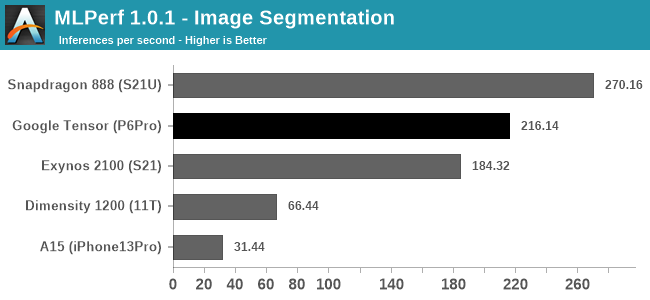
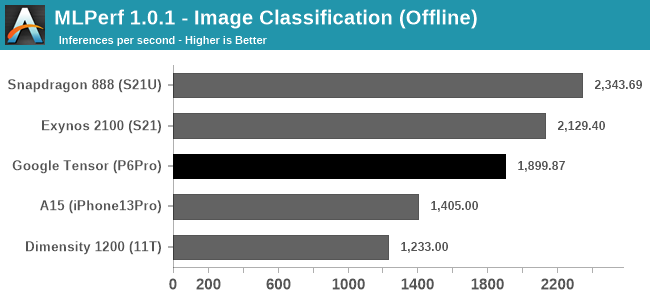
Starting off with the Image Classification, Object Detection, and Image Segmentation workloads, the Pixel 6 Pro and the Google Tensor showcase good performance, and the phone is able to outperform the Exynos 2100’s NPU and software stack. More recently, Qualcomm had optimised its software implementation for MLPerf 1.1, able to achieve higher scores than a few months ago, and this allows the Snapdragon 888 to achieve significantly better scores than what we’re seeing on the Google Tensor and the TPU – at least for those workloads, in the current software releases and optimisations.
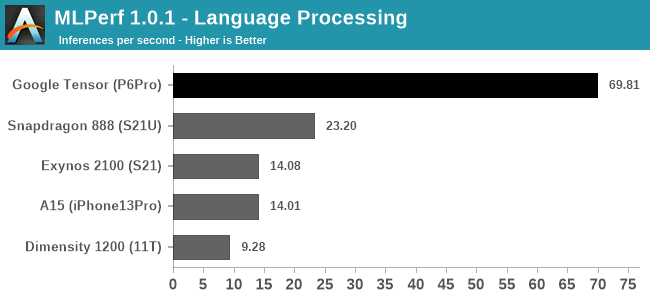
The Language Processing test of MLPerf is a MobileBERT model, and here for either architectural reasons of the TPU, or just a vastly superior software implementation, the Google Tensor is able to obliterate the competition in terms of inference speed.
In Google’s marketing, language processing, such as live transcribing, and live translations, are very major parts of the differentiating features that the new Google Tensor enables for the Pixel 6 series devices – in fact, when talking about the TPU performance, it’s exactly these workloads that the company highlights as being the killer use-cases and what the company calls state-of-the-art.
If the scores here are indeed a direct representation of Google’s design focus of the TPU, then that’s a massively impressive competitive advantage over other platforms, as it represents a giant leap in performance.
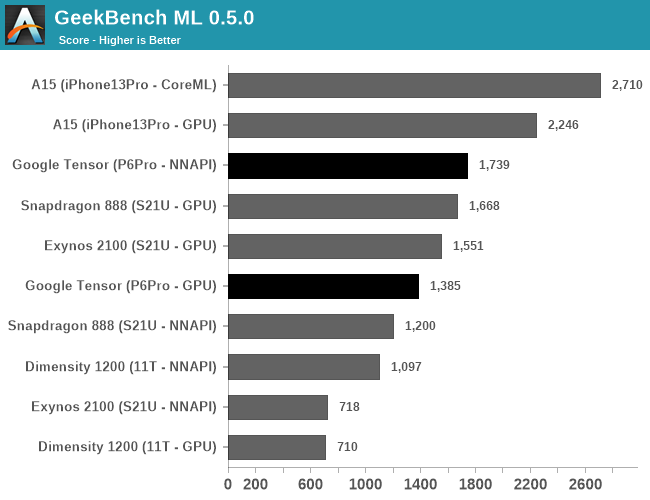
Other benchmarks we have available are for example GeekBench ML, which is currently still in a pre-release state in that the models and acceleration can still change in further updates.
The performance here depends on the APIs used, with the test either allowing TensorFlow delegates for the GPU or CPU, or using NNAPI on Android devices (and CoreML on iOS). The GPU results should only represent the GPU ML performance, which is surprisingly not that great on the Tensor, as it somehow lands below the Exynos 2100’s GPU.
In NNAPI mode, the Tensor is able to more clearly distinguish itself from the other SoCs, showcasing a 44% lead over the Snapdragon 888. It’s likely this represent the TPU performance lead, however it’s very hard to come to conclusions when it comes to such abstractions layer APIs.
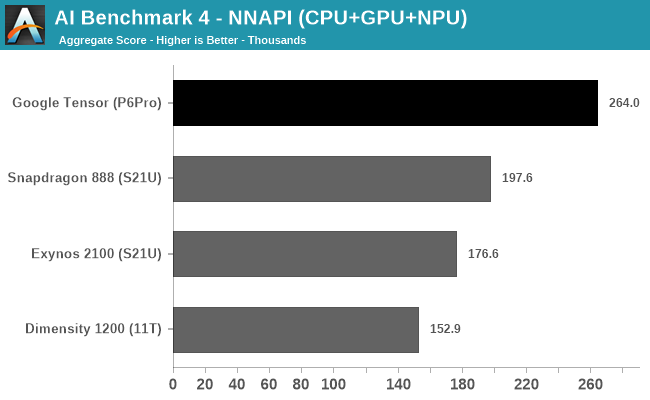
In AI Benchmark 4, when running the benchmark in pure NNAPI mode, the Google Tensor again showcases a very large performance advantage over the competition. Again, it’s hard to come to conclusions as to what’s driving the performance here as there’s use of CPU, GPU, and NPUs.
I briefly looked at the power profile of the Pixel 6 Pro when running the test, and it showcased similar power figures to the Exynos 2100, which extremely high burst power figures of up to 14W when doing individual inferences. Due to the much higher performance the Tensor showcases, it also means it’s that much more efficient. The Snapdragon 888 peaked around 12W in the same workloads, so the efficiency gap here isn’t as large, however it’s still in favour of Google’s chip.
All in all, Google’s ML performance of the Tensor has been its main marketing point, and Google doesn’t disappoint in that regard, as the chip and the TPU seemingly are able to showcase extremely large performance advantages over the competition. While power is still very high, completing an inference faster means that energy efficiency is also much better.
I asked Google what their plans are in regards to the software side of things for the TPU – whether they’ll be releasing a public SDK for developers to tap into the TPU, or whether things will remain more NNAPI centric like how they are today on the Pixels. The company wouldn’t commit yet to any plans as it’s still very early – in generally that’s the same tone we’ve heard from other companies as even Samsung, even 2 years after the release of their first-gen NPU, doesn’t publicly make available their Eden SDK. Google notes that there is massive performance potential for the TPU and that the Pixel 6 phones are able to use them in first-party software, which enables the many ML features for the camera, and many translation features on the phone.










108 Comments
View All Comments
melgross - Wednesday, November 3, 2021 - link
Apple couldn’t integrate Qualcomm’s modems in their own chips because Qualcomm doesn’t allow that. They only allow the integration of their modems into their own SoC. It’s one reason why Apple wasn’t happy with them, other than the overcharging Qualcomm has been doing to Apple, and everyone else, by forcing the licensing of IP they didn’t use.ChrisGX - Thursday, November 4, 2021 - link
Yes, but all that conjecture hasn't been confirmed by any reputable source. And, the statements by Phil Carmack and Monika Gupta indicate Google has been optimising for power (most of all) and performance (to a lesser degree) rather than area. We end up back at the same place, using the A76 cores just doesn't make a lot of sense.Also, the A78 is perhaps 30% larger than the A76 (on a common silicon process) whereas, I think the X1 is about twice the size of the A76. I'm not sure what the implications of all that is for wafer economics but I'm pretty sure the reason that Tensor will probably end up suffering some die bloat (compared to upper echelon ARM SoCs from past years) despite the dense 5nm silicon process is the design decision to use two of those large X1 cores (a decision that Andrei seems perplexed by).
Raqia - Tuesday, November 2, 2021 - link
The Google TPU only trades blows with the Qualcomm Hexagon 780 with the exception Mobile BERT. It's not an especially impressive first showing given that this is Google's centerpiece, and it's also unclear what the energy efficiency of this processor is relative to the competition. It's good there's competition though; at the phone level, software is somewhat differentiated and pricing is competitive.webdoctors - Tuesday, November 2, 2021 - link
Even if the performance isn't impressive, the big deal is guaranteed SW updates. Look at the Nvidia Shield, it came out in 2015 and its still getting the latest Android updates/OS! No other product has been updated for so long, 6 YEARS!Now that Google owns the SoC they have full access to the SoC driver source code so should be able to support the SoC forever, or at least ~10 years....not reliant on Qualcomm's 3 yr support term etc.
BlueScreenJunky - Tuesday, November 2, 2021 - link
Yeah, except they only guarantee 3 years of software update and 5 years of security updates, which is really a shame if you ask me.If they could have guaranteed 5 years of OS updates from the start it would have been a very strong selling point. Especially since the difference between each generation becomes smaller every year, I could see people keeping a Pixel 6 for well over 3 years... How cool would that be to keep a $599 for 5 years and still run the latest android version ?
webdoctors - Tuesday, November 2, 2021 - link
I agree: https://support.google.com/pixelphone/answer/44577...They should've just guaranteed 5 years for SW updates. Based off the pixel 3 being guaranteed for 3 yrs and than this month dropping security updates for Pixel 3 from their list, they're serious about guaranteeing being the maximum support they'll provide which is unfortunate. Maybe they'll update it this year cause that seems like a big hole.
TheinsanegamerN - Tuesday, November 2, 2021 - link
Why? What new features do you NEED in your phone? Android stopped evolving with 9, iOS with about version 11. The newest OSes dont do anything spectacular the old ones didnt do.You're getting 5 years of security updates and dont have apps tied to OS version like apple, giving the pixel a much longer service life then any other phone.
tipoo - Tuesday, November 2, 2021 - link
They're saying 3 years of OS updates, a far shot from 10. 5 years of security updates, which is a start, but owning their supposed own SoC they should have shot for 5 of OS.BillBear - Wednesday, November 3, 2021 - link
After all the build up on "We're going to have our own chips now so we can support them without interference from Qualcomm", three years of updates is seriously underwhelming.Apple has six year old phones running the current OS and the eight year old iPhone 5s got another security update a month ago.
Google needs to seriously step up their game.
melgross - Friday, November 5, 2021 - link
All we know now about software updates is that it will get five years of SECURITY updates, nothing about OS updates was stated, as far as I see. If that’s true, they Google may still just offer three years. Even now, Qualcomm allows for four years of OS updates, but not even Google has taken advantage of it. So nothing may change there.